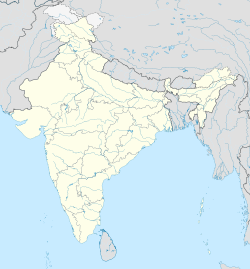Shravanabelagola
| Shravanabelagola | ||
|---|---|---|
|
|
||
| State : |
|
|
| State : | Karnataka | |
| District : | Hassan | |
| Sub-district : | Channarayapatna | |
| Location : | 12 ° 51 ′ N , 76 ° 29 ′ E | |
| Height : | 870 m | |
| Residents : | 6,485 (2011) | |
| View over Shravanabelagola | ||
Shravanabelagola (also: Sravanabelgola , Shravana Belgola ; Kannada : Ś Śravaṇabeḷagōḷa ) is a place with about 6,500 inhabitants in the southern Indian state of Karnataka . Shravanabelagola is one of the most important pilgrimage centers of Jainism in India.
location
Shravanabelagola lies at an altitude of approx. 870 m above sea level. d. M. in the Hassan district , about 143 km (driving distance) west of Bangalore , the capital of Karnataka; the city of Mysore is a good 80 km south. The sanctuary is located on one of the five temple mountains of the Jainas, the approximately 960 m high Vindyagiri Hill (or Indragiri Hill ) and can only be reached on foot via stairs (more than 600 steps). There are also several Jain temples in Chalukya style that are worth seeing on the slightly smaller hill Chandragiri Hill opposite . Between the two hills there is an almost square, man-made temple pond ( belagola ) with gates ( gopurams ) in the South Indian style. The climate is subtropical and warm; Rain falls almost exclusively in the months May to October.
population
Approx. 65% of the population are Hindus , about 15% each being Muslim and Jains ; other religions hardly play a role.
economy
Agriculture is practiced in the vicinity of the village, but the main income comes from pilgrimage tourism.
history
The place is known for the 18 m high figure of Bahubali / Gomateshwara, which was created around 980 AD. The client was the king of the Ganga dynasty, Rachamalla IV (r. 974–984). Under the supervision of his minister or general Chavundaraya (940–989), the statue was carved out of a single boulder.
presentation
The figure represents the Jain ascetic Gomateshvara (also called Gommata or Bahubali), who is completely undressed according to the Digambara custom. His gaze is directed into the distance, ants have built their mounds around his feet and the tendrils of a plant have grown around his legs and arms - a sign of total immersion in meditation.
Legend
Bahubali was the second eldest son of the first Jain Tirthankara Rishabha (also called Adinath ), who was actually king of Ayodhya and Podanpur. However, Rishaba renounced rule over his kingdom while still alive and divided it between his two eldest sons. The eldest of the Bharata brothers then demanded submission and recognition of his sovereignty from all of his brothers, whereupon a fraternal dispute broke out between Bahubali and Bharata, which resulted in a massive deployment of two armies. However, it was decided that the war should not decide between victory and defeat, but a duel between the two brothers, from which Bahubali ( bahu = poor, bali = strong) emerged as the clear winner. However, he decided to continue his life as an ascetic, left the kingdom to the defeated brother and withdrew to the forest, where he meditated completely motionless. After a conversation with their father, however, two of his sisters ( Brahmi and Sundari ) convinced him that his asceticism was based solely on personal arrogance and clinging to his ego, which made the enlightenment ( kevala jnana ) impossible. Recognizing this truth, Bahubali returned to the royal court in order to share the inner experiences and knowledge gained with other people.
Bahubali's meditation corresponds to the ideal of the Jaina doctrine of ahimsa , i.e. H. the complete non-violence and the deep respect for all living things. But the legend is in some traits clearly similar to the Buddha's life and like this Bahubali / Gomateshvara is also regarded as a spiritual teacher who overcame passions such as selfishness, jealousy, pride and anger and came to enlightenment. The return to court and to his father shows parallels to the biblical parable of the prodigal son .
Bahubali / Gomateshvara statues can be found in most Jain temples in India and are easily recognized by the tendrils on his legs.
meaning
In addition to some older cave temples in Ellora ( Maharashtra ) and Badami ( Karnataka ), the mountain temples of Mount Abu ( Rajasthan ) and Shatrunjaya ( Gujarat ) as well as the temple complexes of Ranakpur and Jaisalmer (Rajasthan), Shravanabelagola is one of the most important Jain sanctuaries in India.
Firmly
The Mahamastakabhisheka ceremony takes place every 12 years , to which more than 10,000 devout Jainas but also many onlookers from all parts of India gather. The colossal statue is doused with milk, ghee , coconut milk, honey, yogurt, flowers, colored water and gold coins. Large scaffolding is being erected for this purpose. The last time the event took place in February 2018.
Surroundings
The famous Hindu Hoysala temples of Belur and Halebid are approximately 83 km and 89 km away, respectively. Only 1 km north are the temples on Chandragiri Hill and another 2 km north is the medieval Jain temple of Jinanathapura .
See also
Other colossal Bahubali / Gomateshvara statues stand in
- Karkala (height approx. 13 m; 1432)
- Dharmasthala (height approx. 12 m; 1973)
- Venur (height approx. 8 m; 1604)
- Gommatagiri (height approx. 6 m; 12th century)
literature
- Franz Bätz: Holy mountains, temple cities and ascetics. Jainism - a living culture of India. Weishaupt, Wolfsberg 1997, ISBN 3-7059-0049-8 .
- Gabriele Rosalie Helmer: Stories from Jainism. AVM, Munich 2010, ISBN 978-3-89975-369-1 .



